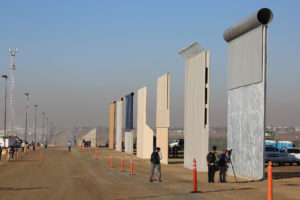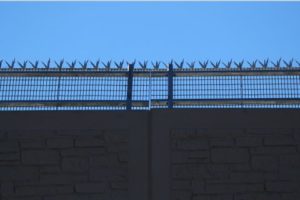“Re/Tracing the Nomadic Subject and Reframing History in Neoliberal Spaces of Security”
A Dissertation Project
“Tell me, Mark Spitz, are you known for your optimistic disposition?”
“Sure.”
“I can tell.” The Lieutenant smiled. “That wall out there has to work. The barricade is the only metaphor left in this mess. The last one standing. Keep chaos out, order in. Chaos knocks on the door and bangs on the wood and gets a claw in, Will the boards hold until morning? You know what I’m talking about if you’ve made it this far. There are small barricades – across the apartment door, then a whole house nailed up – and then we have the bigger barricades. The camp. The settlement. The city. We work our way to bigger walls.”
1
The Wall that delimitates Zone One in Colson Whitehead’s dystopian novel represents neoliberalism’s ultimate technology of biopolitical security. Quartering off lower Manhattan from the rest of the skel-infested U.S. territory, the Wall divides the human from the zombie and, in this way, works to delineate, physically and metaphorically, the distinctions between human and nonhuman, order and chaos, life and death. As the Lieutenant explains, the post-apocalyptic world order rests on the demarcation of borders that multiply outward in an effort to reclaim the territory taken over by the walking dead, but that also reproduce inside the Wall to create tighter and tighter spaces of individualized security. The wall reorganizes national space into inside and outside, determining who belongs – or deserves to be – inside and who must be expelled to ensure the maintenance and safety of human life.
Images of walls permeate contemporary political discourse. Like the Wall in Zone One, this proliferation of walls works to produce a racialized geopolitical hierarchy where safety and security become conflated with exclusion and segregation. As Wendy Brown states, walls “emerge from and figure in discourses, they can become discursive statements themselves, and they are crucial to the organization of power in and through space.”2 One might think of the border that separates the state of Assam from Bangladesh: in the city of Dhubri, a 76-km barbed wire fence protects Indian territory from Bangladeshi “infiltrators” who, forced out of their homes by natural disasters and environmental degradation, sneak across in an effort to escape their country’s precarious living conditions.3 But it is Trump’s “see-through wall” 4 that best embodies the exclusionary and paranoid discourse of neoliberal biopower, as it articulates the foreign other, specifically the Mexican, not only as a burden on U.S. economy, but most importantly as a weapon of death that can, at any moment, slide under or climb over the border to threaten the livability of the “good, god-fearing American.”
- Trump’s prototype walls
- The “see-through” and the “solid” walls
- The “see-through” wall must ensure that the “other” is in sight of the North American patrols at all times
- All walls had to be tested to ensure that they were impenetrable from both below and above.
If walls are designed to keep the other out, they also work to lock the subject in. And in this process of blocking out/walling in, contemporary walls define spaces of identification and estrangement, delineating the border between the internal “we” that the state must secure and the external “they” that must be at once contained and expelled. In its delineation of who is in and who is out, neoliberal biopower operates to determine whose life is worth preserving and whose must be sacrificed for the safety of the nation-state. As a result, the wall also redefines who counts as human and who counts as less human or perhaps who is not human at all by determining who is allowed to live inside the wall and who must be left to die on the outside – Whitehead’s zombies, Bangladesh’s environmental refugees, Mexico’s “criminals.”
With the image of the wall as a strategy of biopolitical regulation in mind, my dissertation examines the way in which contemporary authors articulate and represent the new subject formations that emerge at the intersection of neoliberal ideology, biopower and capital. I will trace the trajectories of becoming human and non/posthuman in relation to the proliferation of spaces of security and securitization that emerge with neoliberal discourse and that work to redefine, reinforce, but also potentially collapse, the ontological distinctions between categories of life and being. Through a close-reading of the clone in Kazuo Ishiguro’s Never Let Me Go and Graeme Manson and John Fawcett’s Orphan Black, the zombie in Colson Whitehead’s Zone One and Junot Díaz’s “Monstro,” the hybrid human-animal in Indra Sinha’s Animal’s People and Lauren Beukes’ Zoo City, and the alien in Neill Blomkamp’s District 9, I will focus on nonhuman and posthuman bodies as spaces for the negotiation of species identity, with particular attention to the ways in which neoliberal biopower deploys life, death and capital as strategies of dehumanization of gendered, racialized and naturalized subjects.
Through a reading of the relationship between secured spaces and non/posthuman bodies, I will argue that, in its process of inclusion/exclusion, the neoliberal state produces the very subjects that it needs to expel in order to legitimate its power. My analysis will closely follow Michel Foucault’s description of the emergence of biopolitics and the formation of American neoliberalism.5 In his lectures, Foucault traces a genealogy of governmentality from what he terms “technologies of surveillance,” which work to produce the individual subject through sustained observation, to much less visible “mechanisms of security” that act on the population as a whole to optimize the modern nation-state. Following Foucault’s line of inquiry, I will also examine the distinct ways in which contemporary authors depict neoliberalism as a set of values and practices that aim to regulate and subsume the subject under a series of mechanisms of security employed in the name of capital.
Come with me on this adventure through neoliberal spaces, dark places and strange bodies!
Chapter One
Chapter Two

Chapter Three

Chapter Four

Chapter Five

- Whitehead, Colson. Zone One. Anchor Books, 2011, pp. 121. ↩
- Brown, Wendy. Walled States, Waning Sovereignty. Zone Books, 2010, p.74 ↩
- Funk, McKenzie. Windfall: The Booming Business of Global Warming. New York, Penguin Books, 2015, p.122 ↩
- Smith, Allan. “Trump doubles down on the need for a ‘see-through’ border wall because he wants ‘to be able to see.’” Business Insider, 12 January 2018. ↩
- Foucault, Michel. The Birth of Biopolitics, Lectures at the Collège de France 1978-1979. Transl. Graham Burchell. Palgrave Macmillan, 2008. ↩




